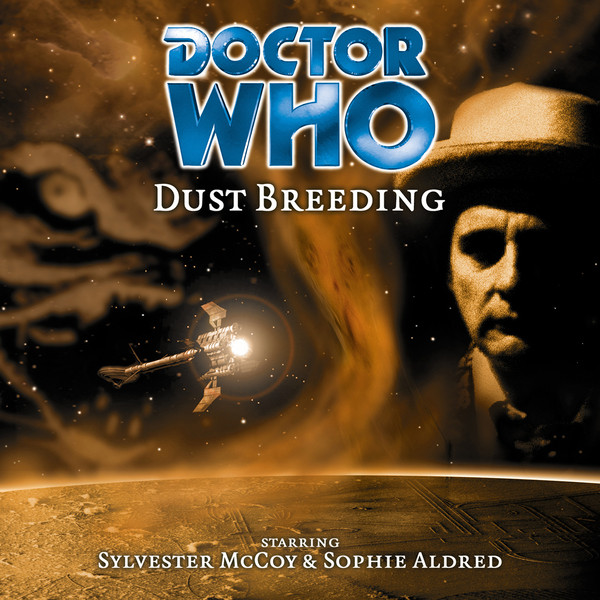
Released June 2001
‘Dust Breeding’ finally brings the Master into the Big Finish universe, with Geoffrey Beevers reprising the role. Big Finish apparently originally intended to have Anthony Ainley return as the Master, but his demands were too much to make his reprisal a realistic possibility. As it is, however, Beevers possesses a voice that simply exudes everything that is the Master, and so his presence in ‘Dust Breeding’ is superb even if the plot contrivance to explain his being back as a post-‘Survival’ Master is rather overly complicated.
The Master’s nefarious plan is to gain control of the sentient Warp Core weapon by using eggs of the Krill, a humanoid creature first seen in the novel ‘Storm Harvest;’ of course, it doesn’t go exactly as he envisions and the Doctor ends up intervening. Actually, though, ‘Dust Breeding’ is full of intriguing concepts, notably a planet as a work of art and sentient dust-like beings that spend centuries trapped inside the painting ‘The Scream’ with the Doctor rushing to save that same painting before its destruction. Unfortunately that sentient superweapon that became more powerful than its creators foresaw never really reaches its full potential and in a sense becomes just another routine power for the Doctor to go up against. However, the story also makes good use of the Daleks without actually having them present in the story. The planet Duchamp 331, the setting of ‘Dust Breeding,’ has a legend that the background noise on the planet is the result of a Dalek saucer having crashed long ago and its crew being sucked into the omnipresent dust. It’s quite disconcerting to hear what are clearly Dalek cries so continually, but the effect is a great one nonetheless, and one that has never before or since been replicated.
The Doctor and Ace are fantastic as always, Sophie Aldred bringing a more vulnerable side of Ace to the forefront, and Beevers effortlessly returns as the Master at his most conniving and menacing. McCoy and Beevers capture the nuanced relationship between the Time Lord foes excellently despite never having confronted each other on screen, and this relationship truly drives the story along. However, the rest of the supporting performances are quite strong as well. Louise Faulkner’s Bev Tarrant, last heard in ‘The Genocide Machine,’ returns as another surrogate companion for McCoy and she fills the role admirably while rounding out her character a bit more fully. Johnson Willis’s portrayal of the crazed Damien is inspired, becoming even more emotionally manic when he joins with the Warp Core, and Ian Ricketts is also quite fun as the heroic Guthrie. Undoubtedly, though, the other notable big piece of casting is in Caroline John who, while not returning to the role of Liz Shaw she made famous alongside Jon Pertwee, gives a very memorable performance as the art dealer Madame Salvadori. Her accent is maybe a little ostentatious, but it never detracts from her scenes, and it’s immense fun to have the real-world couple of Shaw and Beevers together in a Doctor Who performance.
Mike Tucker again proves that he’s something of an expert on the Seventh Doctor and Ace era of the programme, and the characterization of both is top-notch. With strong supporting performances and a rich atmosphere, ‘Dust Breeding’ comes as a genuine surprise from Big Finish that should quite successfully stand the test of time. The Doctor’s collecting of art treasures at points when they ‘historically vanish’ is a little suspect and, although it keeps in line with references about his collection he made in ‘City of Death,’ seems like a quirk more in line with the Meddling Monk than the Doctor. Still, it sets the plot in motion and what follows is a fun and emotional tale that tonally fits in well with the late 80s and The New Adventures range.
- Release Date: 6/2001


Leave a Reply